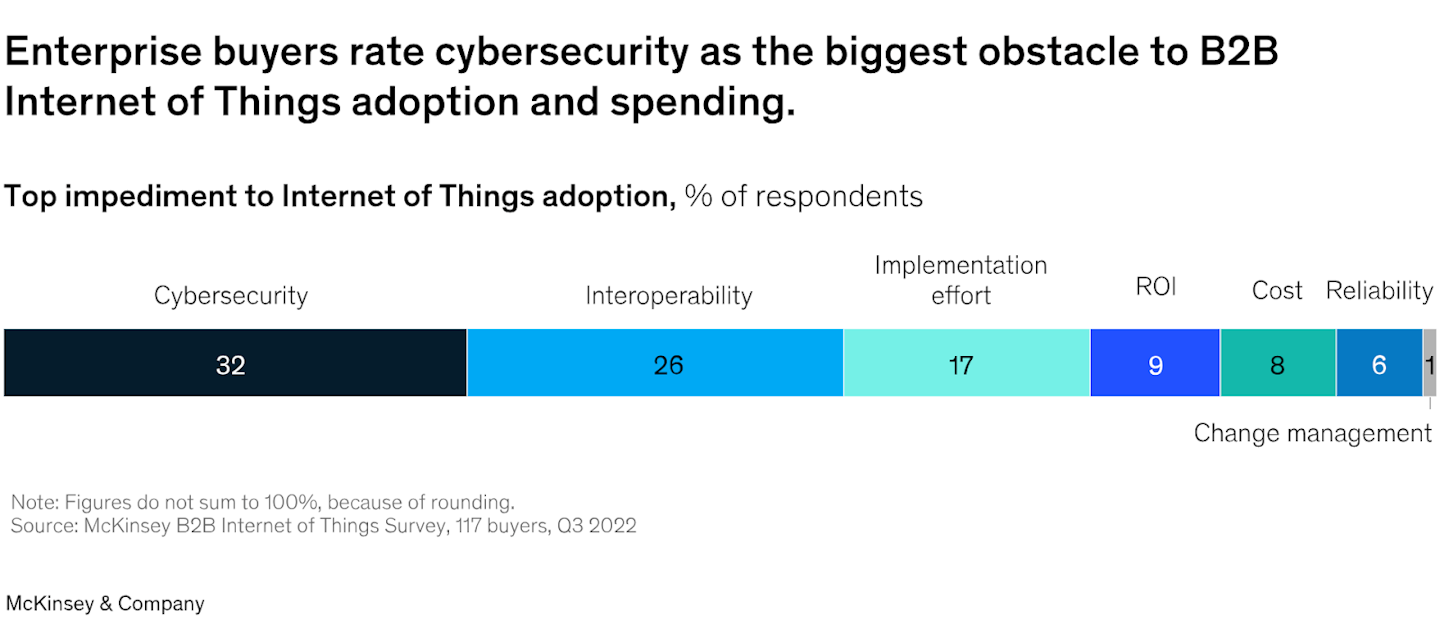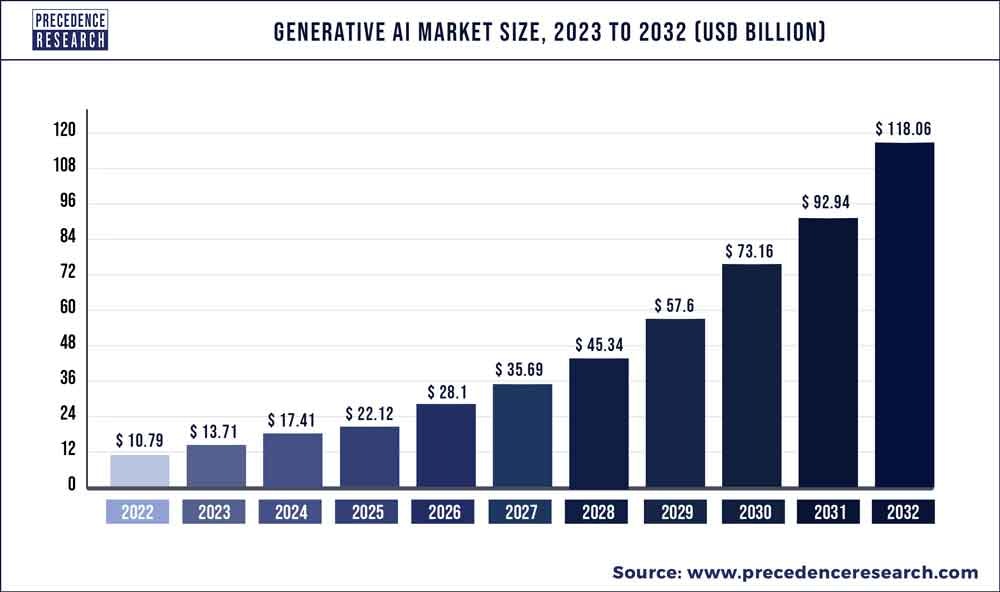With predictions about the global economy and the status of megacities unfolding by the minute, we’re bringing forward a less bold collection: a list of emerging technologies we’ll learn about during this year. Every outlined tech could belong to articles from past years, but, in 2025, these are further from being science fiction than ever before — and closer to amassing interesting interesting market capitalisations. These are the emerginig technologies we’ll learn about in 2025 and that could potentially mean jobs:
1. Cybersecurity for IoT
Alright — calling cybersecurity an emerging tech can seem like a stretch. In any case, it’s been emerging for years, but in the minds of CISOs, who can’t lay back and rest even during their PTO because there always seems to be a new threat. Unfortunately, their worries are founded. To companies, hospitals, governments and whoever touches a keyboard, cyberattacks still cost trillions (at least reportedly) of dollars in damage. Since people working in tech don’t want to be held accountable for a hack, they’ll naturally push their companies to invest in whatever the vendor asks in return for some solutions (and some protection).
But if you watched the awful film Leave the World Behind (2023), a new Netflix disaster–family drama flick with a bafflingly underwhelming ending, you’ll know that cybersecurity could have higher stakes than ever before. With billionaires peddling self-driving cars and interconnected traffic lights as if bicycles were a fad, cybersecurity will play a new role in protecting us from child hackers changing our driving paths from a fast food restaurant to a coffee store.
So, now that our coupé automobiles will be connected to the internet, cybersecurity for IoT could be an emerging technology to save us all from an eerily dystopian future in which we try to avoid visiting our aunts but our car drives us up to their front lawn.
It is to be seen how IoT cybersecurity runs, and where. Cybersecurity for desktop computers has a long history: an antivirus client will prevent a program called Trojan_Horse.exe, downloaded right through a legacy P2P software, from opening up and wreaking havoc. Now, since cars, traffic lights, and fridges will have adapted operating systems, we should pay attention to how the smarter vendors sort out a world in which generative AI means that classic cyber threats can be redone with a slightly different signature, millions of times, and in which the platforms where the threats are targeted at are more niche than a Windows desktop computer.
(We hope you didn’t watch Leave the World Behind, though. Where’s the emerging technology that will prevent humans from being exposed to such awfully makeshift #content that’s more distressing than the prospect of a hack-induced apocalypse?).

2. Generative AI
ChatGPT, Bard, and such — they took the world and our doomscroll by storm. And then there are those handy tools that devs can't get enough of, like Tabnine. Well, they're still pretty innovative, but all these are mainly designed for generating text, code, images, and sound. That’s why they’re called generative AI.
And with so much cash being poured into its further development, it's a bit of a stretch to think generative AI will be happy playing in the same sandbox forever. The next few years will likely see it branching out and making its mark in all sorts of unexpected ways. Drug design, architecture, and engineering are some promising areas where this tool is expected to expand.
As early as June 2023, articles were published on the design of molecules by gen AI to fight diseases and on interior design projects entirely generated by this technology. So we can predict some headlines: In 2024 and onwards, certain gurus will tell us that gen AI is getting creative, absorbing the intellectual capacities of humanity and something that could be much more constitutive of our species than just typing up words. That same creative power that Renaissance humanism postulated as the human quality that brought us closer to deities.

3. Flexible batteries
Influencers are scoring viral videos by making fun of PCs, and, as devices become smaller and more portable, complaints about them keep piling up. People say personal computers are too heavy, too big, or just a pain to lug around, among other things. One way to defeat those conceptions would be through flexible batteries that, let’s say, could power computers that can roll-up and fit bigger screen sizes in a backpack. And these batteries, of course, could fit into other “devices” — such as the shirt you dress up for Zoom meetings with.
Flexible batteries would work with your easy-iron shirt because they can bend and flex. They often use lithium-ion or zinc-carbon setups on conductive polymer. Now, the battery bits can either be slapped or printed onto flexible stuff, like carbon-based materials such as graphene, carbon fibres or cloth. The idea is to make gadgets flexible and wearable without losing any power.
As mentioned earlier, e-textiles or “smart” clothing is a promising area for development and investment in this emerging technology. Maybe in a few years, if the systems that turn salt water into drinking water don't catch on, we'll be rocking outfits that, like the Fremen in Dune, turn sweat into drinking water to combat the growing freshwater shortage. That’s at least more pragmatical than powering up your remote-meeting white shirt, but, well, perhaps someone will come up with a way to leverage a flexible battery on it. How about it features a fabric that, upon a small electric shock, becomes as flat as if it had been ironed out with a lead press? It would certainly be cool.
A study already forecasts that the global flexible battery market will grow by $240 million from 2022 to 2027, and some other studies are even more optimistic. LG Chem, Samsung SDI, Apple and Nokia — remember them, millennials? — are some of the companies that are already investing in this market. Which clearly signals that the biggest market for these flexible batteries might be smartphones. We’ll be learning more about this tech in 2024.

4. Carbon capture and storage (CCS)
Companies, countries, and NGOs alike are signing up for the highly-publicised 2030 Agenda for Sustainable Development, with the purpose of facing up to the effects of climate change and global warming. Some companies have taken it very seriously. Take Microsoft, which pledged to go carbon negative by that very year. Moreover, the European Union has been investing significantly in such technologies as part of efforts to reduce carbon emissions and combat climate change, including technologies from the carbon capture and storage (CCS) niche.
CCS — don’t think it’s CSS — is designed to mitigate carbon dioxide emissions from industrial processes and power generation. How does it work? It can be explained in three simple scholarly steps that involve the capture of carbon dioxide generated from power generation or industrial processes like steel or cement manufacturing, its subsequent transportation, and eventual storage deep underground.
CCS's role in carbon reduction isn’t insignificant at all. According to a report from the IEA in 2019, which simulated scenarios for meeting the goals of the Paris Agreement, carbon capture is projected to play a role in achieving 27% of the required emissions reductions within the cement, iron, steel, and chemicals industries.
Because of all these things, CCS’s market also represents a relevant investment opportunity. Its size exceeded USD 6 billion in 2022 and is expected to grow by more than 20% by 2032. Not bad, right?

5. Virtual reality (VR)
What’s your dream job? Many millennials and Gen Zs will say: “Whichever job that allows me to spend my afternoons in a Caribbean paradise.” Quite naturally, managers will scoff at this prospect and share a very valid riposte: You’d only be able to sustain such a job if you could teleport to the beach. Virtual reality (VR) doesn't literally teleport us, but it has the capability to recreate the Caribbean right in our room.
VR involves the use of advanced technology, typically through a headset or immersive display, to simulate an artificial environment that users can interact with. This tech was initially associated with gaming because of games like Half-Life: Alyx. However, VR has transcended this initial association and found applications across various domains, such as medicine, culture, education, architecture, or productivity in the sense a desktop computer carries. For example, Apple’s publicised Vision Pro is, according to some observers, a VR tool, and it could allow you to work from a virtual keyboard with the ebb and flow of a Caribbean tide in the background. It won’t matter if you’re actually in a café.
One interesting use for VR is in the “metaverse of mental health.” Spending too much time on screens and playing games together could help with mental health problems instead of worsening them. Just picture being super stressed from work and being able to take an hour on a row boat in the middle of the lake with your therapist on a guided meditation.
The global VR market is on a steady growth trajectory, driven by the increasing affordability of VR hardware and its diverse applications in key sectors. And Apple still claims that their device is more of an augmented reality tool — like Pokémon Go, for example — so better keep an eye out for varying revenue projections.

6. Sustainable computing
Yeah, sustainable is about to lose its meaning, and even the worst altcoins out there are “sustainable.” But let’s focus on the facts: Processing, computing, and every task that a computer performs does still require energy, and experts estimate it consumes about 1% of the world's produced energy. Some researchers even estimate it uses 10%. So, bear with us: There is actual room for improvement on the data processing sustainability. This is why the growth of sustainable computing stands out as a promising technology that will likely get attention.
One key focus is on enhancing energy efficiency in both hardware design and the operation of data centres, where massive amounts of digital information are processed. The approach also stresses material efficiency, recycling, and responsible disposal of electronic waste to minimize environmental harm. There are companies even using the flaring process (burning leftover gases in oil sites) to power up data centres.
Then, there's the AI superhero stepping in. There are reports of companies using AIs for analysing and fine-tuning energy use on the go. DeepMind even managed to pull off a 40% reduction in energy use at Google's data centres.
Lastly, the setup for net-zero-energy data centres is becoming modular and adaptable. Cloud and edge computing spread out the workload across different gadgets and locations. These prefab units are easy to set up, expand, or move. As with so many buzzwords, companies will likely change the meaning behind “sustainable” if it paints them as heroes, so we’re set to read a lot about sustainable computing in 2024.
Emerging technologies should mean emerging jobs
These emerging technologies have clear cash horizons, with organisations estimating they’ll be markets of hundreds of millions of dollars each. This, of course, could mean jobs for people who can specialise in making these trends more than 12-month crazes. Software engineers who know how to program with security in mind, cloud engineers, or AI engineers would definitely earn a post with these trends.
In any case, you can always be on the lookout yourself. At WeAreDevelopers, we continually match the best talent in Europe with the best companies. Go out and check our job boards so you can land your next job in an emerging tech. Good luck!
.webp?w=720&auto=compress,format)